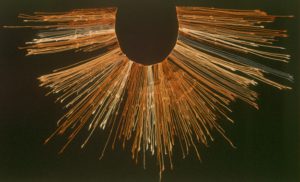
Professor Sabine Hyland of the University of St Andrews has been studying khipus for over 15 years, teaming with Andean locals to solve the enigma of this mysterious form of writing with strings. She has collaborated with elders in remote Andean villages, seeking to discover new insights into how native Peruvians communicated through these cords. Her research has uncovered isolated communities where khipus – once thought to have been wiped out during European invasion in the 1500s – were used within living memory. Hyland’s work has demonstrated, among other things, that khipus communicated their messages partially through the tactile feel of different animal fibres and the twist of knots and thread, suggesting an indigenous epistemology in which the sense of touch plays as vital a role as sight.
The Incas kept their accounts, histories, and sacred knowledge on khipus and Professor Hyland believes that if we could decipher these knotted cords, we could gain an insider’s view to their extraordinary empire.
If, like me, you find this a fascinating subject, then you can watch and listen to Professor Hyland tomorrow, via Microsoft Teams (it’s not necessary to have a Teams account to take part), as she presents “Unravelling an Ancient Code Written in Strings” on Tuesday 2nd November at 5.15pm GMT. You can register at this link: https://www.st-andrews.ac.uk/develop-2/sainttalk/
David Orr, Director, Global Connects
